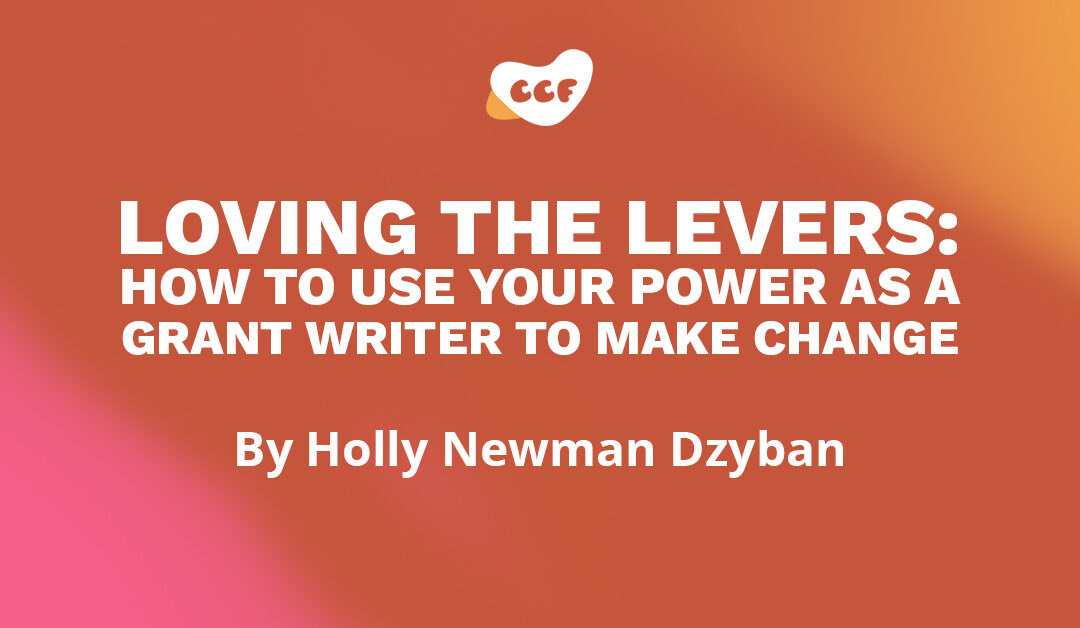By Holly Newman Dzyban, who is always ready to fight for a good cause
Even if you are a low-level employee, you don’t have to just sit by—and you definitely don’t have to hide your nonprofit’s sins… Grant writers have the power to center those injustices and keep our nonprofit’s attention on them until it’s easier to deal with them than look away.
For me, nonprofit work and grant writing were an accident. I started as an AmeriCorps VISTA for a Tribal language program. They needed money, someone forwarded me a grant application, and I got busy. A few decades and about $10 million later, I keep coming back to grants.
The work sings to me because I am mission-driven and I love to write, yet over the years I realized that there is more to my role than words and money.
As a grant writer, I hold a lot of power.
It doesn’t seem like I should. If my title is grant writer, I am definitely not the formal leader of the organization. Yet I introduce the nonprofit to people the ED may never meet. For these people, my words—how I describe the work we do, our mindset and values—establish the organization’s identity.
That’s a serious responsibility, so over the years, I’ve worked closely with many EDs to ensure that my descriptions reflect reality.
But sometimes, sometimes, reality isn’t what we want it to be. Maybe the project the ED wants you to pitch isn’t quite as thought out as it should be. Maybe the staff is dealing with conflict and division. Maybe leadership is dragging its feet on addressing racist structures.
Even if you are a low-level employee, you don’t have to just sit by—and you definitely don’t have to hide your nonprofit’s sins. I was raised with the mindset that if you see injustice, you have a duty to use whatever power you have to do something about it. Grant writers have the power to center those injustices and keep our nonprofit’s attention on them until it’s easier to deal with them than look away.
Here are six ways to do it:
- Use grant application questions to prod your leadership to address problematic practices.
One far-too-common problem is excluding clients from planning and operations. Yet funders often ask directly about this dynamic: How is your organization participant-led? How does this project incorporate participant feedback?
I love these questions because they show an awareness that our clients are the experts on their own lives. They know what kind of support they need and how to make it work for them.
Despite this, nonprofits often do not develop programs in partnership with the people they are supposed to benefit. What I usually see is a concept envisioned by an ED. Then the staff creates a plan around the idea, recruits participants, and launches the program. Occasionally, participants will get to share feedback afterward.
As a grant writer, you can steer your nonprofit toward a more just relationship with participants. When a grant application includes this question, take it to your ED. Ask them how they would answer it for this project at this time. If your organization doesn’t obtain participant input, don’t try to hide it. Tell the funder.
When the grant is rejected, take it back to your ED. Explain why that approach doesn’t work. Emphasize how often this question comes up and how much funders want to see participant-driven programs. If the funder provided specific feedback, share that as well.
Then work with your ED to brainstorm a new way to plan—one that includes clients. And look for capacity-building grants to support your organization’s efforts to grow out of the status quo.
- Leverage outside influences to prod your leadership to address problematic power structures.
No one likes to hear that a grant they wrote was declined. But rejection and the accompanying feedback have a power all their own.
I once worked for a nonprofit serving a client base that was 75% people of color, yet our board was 75% white. Though our staff had been pointing out the problem for years, the board’s diversity commitment remained hollow. It didn’t gain traction until I could point to feedback from funders that our leadership did not adequately reflect the audience we served. The board saw that the gap was costing our agency money, and change was afoot.
Should we have to rely on a “higher” power to make change? No, of course not. Organization and board leadership should listen to staff, especially those who work directly with the clientele, and especially when it comes to DEI issues. But when an organization is stuck in old thinking, there is no shame in drawing on powerful allies to light a fire under leadership.
- Leverage budgets to embed wage justice in grant commitments.
Many grant applications require a project budget and budget narrative. For ongoing programs, it’s easy to just plug in figures from the current year’s budget.
But consider this: The grant won’t be awarded for months. Who knows what will change before then?
In a funding application to pay staff salaries, I budgeted $150K, basing my proposal on what my coworkers were earning at the time. A few months later, my agency set a new minimum salary, resulting in significant raises for our front-line staff. I was thrilled to see everyone earn a living wage. But because the raise was under wraps when I submitted the grant, the figures were all off when the grant was awarded. I had to jump through all kinds of hoops to revise the budget.
Learn from my mistake. Instead of aligning your grant budget with current wages, factor in cost-of-living increases. When the grant is awarded, your leadership team will not only have the money for COLA—it will also have an incentive to live up to the submitted budget.
- Leverage data to disrupt external power dynamics.
For small nonprofits, government funding can seem like the holy grail. It’s consistent. It’s often renewable. And receiving it means your agency is being taken seriously.
Yet it’s no secret that government contracts don’t fully pay for the work they are supposed to fund. Overhead rates are often fixed at 10%, regardless of how much it costs to operate an organization.
But this chronic underfunding won’t change unless nonprofits push back—and by nonprofits, I mean grant writers. You have relationships with the government and foundation funders. Be honest with them about the full cost of doing business.
This article is a great place to start: https://www.bridgespan.org/insights/library/pay-what-it-takes/pay-what-it-takes-philanthropy.
And don’t be afraid to walk away from funding. If the cost of taking on that grant project is more than your nonprofit can afford, don’t accept the grant. But to maintain that relationship, you must be open and upfront with the funder about why you’re turning down their offer.
- Cede power.
I often serve as the face of my nonprofit during funder visits. Because I wrote the grant that brought the funder to our door, I’m sometimes the only person who knows exactly what we promised to do with the money—even though I’m not doing the work myself.
But what about the people who are doing the funded work? Shouldn’t they be the face of the organization? Should I really have this seat at the table just because I write well?
Talk about privilege!
A few years ago, I pitched a career pathways project to a major city funding body. My nonprofit was invited to speak directly with the advisory committee about the program and how it worked. We could send five staff to the interview.
I was the de facto lead of the interview team, but so many amazing people were involved that I had trouble narrowing it down to just four other interviewees. From the program director, who was from the community we aimed to serve, to the coordinator drawing on their own career pathway experience, they all had so much more to offer to the conversation than I did. So I took a deep breath and let go of my seat at the table. I prepped the interview team so they knew that grant inside and out, and they knocked it out of the park.
Did we receive the grant? No. But I still believe we made the right choice—and the comments from the funder made it clear that they respected our approach.
- Work with your eye on the long game.
Inequity and injustice are infuriating, and we want them to be fixed now. But most people (even those with massive power) are not villains. Find what you can agree on, and make progress while you build a deeper relationship. Then you can leverage the relationship to grow more common ground.
We are all messy and complicated. We can cut out the people we disagree with, but that robs us of the chance to see them grow—and we all have room to grow. Seeing and loving one another despite our worst is what makes justice possible.

Holly Newman Dzyban
Holly Newman Dzyban (she/her) is a grant writer, rabble-rouser, peace-maker, and perennial volunteer. Raised crossing contexts as a military brat, she constantly looks for barrier-constructs to disrupt and mindsets to unsettle. Currently daylighting in grants for a Washington-based nonprofit, her history spans science education, the local foods movement, and revitalizing indigenous languages. She loves grammar jokes and watching her kids interrogate their own realities. You can connect with her on LinkedIn.
Discover more from CCF
Subscribe to get the latest posts sent to your email.


Excellent article Holly! Will be sharing this widely with those in the non-profit world. You have explained so much of the way we can navigate our power and privilege for change. I do think we need to consider time and energy and prioritize where to direct our focus when it comes to the last point you make (e.g. sometimes better to cut out misalignment than ignore more meaningful opportunities for growth and change by struggling to work with harmful actors. And I believe there are bad actors out there), but I do appreciate how well you explain the grant process and power for change because it will help so many stay in integrity and make an impact.
Holly, glad to see how you have grown and evolved since we worked together. Your article is right on point whether for non profit or a Tribe. We’re looking for someone with your approach on our team in Winnebago.